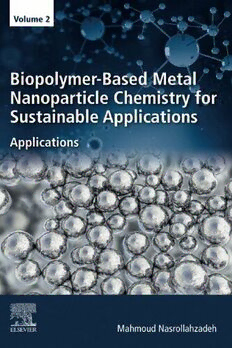
Biopolymer-Based Metal Nanoparticle Chemistry for Sustainable Applications. Volume 2: Applications PDF
Preview Biopolymer-Based Metal Nanoparticle Chemistry for Sustainable Applications. Volume 2: Applications
Biopolymer-Based Metal Nanoparticle Chemistry for Sustainable Applications Biopolymer-Based Metal Nanoparticle Chemistry for Sustainable Applications Volume 2: Applications Mahmoud Nasrollahzadeh Department ofChemistry, Facultyof Science,University ofQom, Qom,Iran Elsevier Radarweg29,POBox211,1000AEAmsterdam,Netherlands TheBoulevard,LangfordLane,Kidlington,OxfordOX51GB,UnitedKingdom 50HampshireStreet,5thFloor,Cambridge,MA02139,UnitedStates Copyright©2021ElsevierInc.Allrightsreserved. Nopartofthispublicationmaybereproducedortransmittedinanyformorbyanymeans, electronicormechanical,includingphotocopying,recording,oranyinformationstorageand retrievalsystem,withoutpermissioninwritingfromthepublisher.Detailsonhowtoseek permission,furtherinformationaboutthePublisher’spermissionspoliciesandourarrangements withorganizationssuchastheCopyrightClearanceCenterandtheCopyrightLicensingAgency,can befoundatourwebsite:www.elsevier.com/permissions. Thisbookandtheindividualcontributionscontainedinitareprotectedundercopyrightbythe Publisher(otherthanasmaybenotedherein). Notices Knowledgeandbestpracticeinthisfieldareconstantlychanging.Asnewresearchandexperience broadenourunderstanding,changesinresearchmethods,professionalpractices,ormedical treatmentmaybecomenecessary. Practitionersandresearchersmustalwaysrelyontheirownexperienceandknowledgeinevaluating andusinganyinformation,methods,compounds,orexperimentsdescribedherein.Inusingsuch informationormethodstheyshouldbemindfuloftheirownsafetyandthesafetyofothers, includingpartiesforwhomtheyhaveaprofessionalresponsibility. Tothefullestextentofthelaw,neitherthePublishernortheauthors,contributors,oreditors, assumeanyliabilityforanyinjuryand/ordamagetopersonsorpropertyasamatterofproducts liability,negligenceorotherwise,orfromanyuseoroperationofanymethods,products, instructions,orideascontainedinthematerialherein. LibraryofCongressCataloging-in-PublicationData AcatalogrecordforthisbookisavailablefromtheLibraryofCongress BritishLibraryCataloguing-in-PublicationData AcataloguerecordforthisbookisavailablefromtheBritishLibrary ISBN:978-0-323-89970-3 ForinformationonallElsevierpublications visitourwebsiteathttps://www.elsevier.com/books-and-journals Publisher:SusanDennis AcquisitionsEditor:AnnekaHess EditorialProjectManager:JohnLeonard ProductionProjectManager:JoyChristel NeumarinHonestThangiah CoverDesigner:MarkRogers TypesetbySPiGlobal,India Table of Contents 1. Application of Biopolymers in Bioplastics Part 1: Biopolymer-based structures and the Food Industry 2. Polysaccharides in the Food Industry 3. Proteins in the Food Industry 4. Food Packaging Applications of Biopolymer-Based Nanomaterials Part 2: Biomedical and Biological Applications of Biopolymer-Based Nanomaterials 5. Biomedical Applications of Biopolymer-Based Nanomaterials 6. Biological Applications of Biopolymer-Based Nanomaterials Part 3: Further sustainability Applications of Biopolymer-Based Metal Nanoparticles 7. Catalytic Applications of Biopolymer-Based Metal Nanoparticles 8. Environmental Applications of Biopolymer-Based Nanomaterials 9. Biopolymer-Based Metal Nanoparticles for Biosensing 10. Biopolymer-based Nanomaterials for Supercapacitor Applications 11. Biopolymer-based Nanomaterials for Hydrogen Storage Index Contributors Numbersinparenthesisindicatethepagesonwhichtheauthors’contributionsbegin. MahmoudNasrollahzadeh(1,47,97,137,189,333,423,517,573,609,673), DepartmentofChemistry,FacultyofScience,UniversityofQom,Qom,Iran ZahraNezafat(1,47,97,137,189,333,423,517,573,673),DepartmentofChemistry, FacultyofScience,UniversityofQom,Qom,Iran NasrinShafiei(1,47,97,137,189,333,423,573,609),DepartmentofChemistry, FacultyofScience,UniversityofQom,Qom,Iran FahimehSoleimani(47,189,333,673),DepartmentofChemistry,FacultyofScience, UniversityofQom,Qom,Iran NayyerehSadatSoheiliBidgoli(137,189,333,423),DepartmentofChemistry, FacultyofScience,UniversityofQom,Qom,Iran TalatBaran(189,333,573),DepartmentofChemistry,FacultyofScienceandLetters, AksarayUniversity,Aksaray,Turkey MohaddesehSajjadi(517),DepartmentofChemistry,FacultyofScience,Universityof Qom,Qom,Iran GurumurthyHegde(609),CentreforNano-materialsandDisplays,B.M.S.Collegeof Engineering,Basavanagudi,Bengaluru,India xi Chapter 1 Application of biopolymers in bioplastics Mahmoud Nasrollahzadeh, Nasrin Shafiei, and Zahra Nezafat DepartmentofChemistry,FacultyofScience,UniversityofQom,Qom,Iran 1.1 Introduction Plasticsarewidelyutilizedmaterials.Theyaredailyusedalmosteverywhere:in cell phones, packaging, toys, printers, pharmaceutical industry, electronics, automobiles, textiles, etc. Since 1940s, synthetic plastics have attracted a lot of attention due to their remarkable properties such as mechanical strength, lightness,flexibility,anddurability.Thesepropertiesareassignedtoamaterial oflowcost,whichiscapableofreplacingproductsmadefromothermaterials includingpaper,glass,andmetal[1,2].However,thereisanall-knownconcern aboutthedamagesmadebypetrochemical-derivedplasticstotheenvironment afterdisposal.Forinstance,mostlyaround7.8–8.2milliontonsoftheplastics entertheoceanseveryyear.Thenegativeeffectofthislong-lastingcontribution to environmental contamination is depicted inFig.1.1 [3–5]. Therefore,researchershavebeentryingtofindeco-friendlyalternativesto manage the waste of plastics, which resulted in the study, production, and utilization of “bioplastics.” Bioplastics are plastics, which are biodegradable, biobased, or both. Examples of well-known, nonbiodegradable and biobased plastics include polyethylene (PE), poly(ethylene terephthalate) (PET), and polyamide(PA),poly(trimethyleneterephthalate)(PTT).Petroleum-basedbio- degradable plastics include polybutylene adipate terephthalate (PBAT) and polycaprolactone(PCL).Someplasticssuchaspolylacticacid(PLA),polyhy- droxyalkanoates(PHAs),polybutylenesuccinate(PBS),andstarchblendsare both biobased and biodegradable (Fig. 1.2). Biodegradability of a compound meansthatitcanbebrokenintosmallerparts byenzymaticactions ofmicro- organismstoformcarbondioxide,methane,water,biomassandvariousother naturalsubstances,whichcanbeeasilyeliminated.Thebiodegradationmech- anism depends on the thickness and composition of the material. The term biobased plastic refers to plastics derived from natural sources or biomass. Theymay be biodegradable or not, butthey are recyclable [6, 7]. Biopolymer-BasedMetalNanoparticleChemistryforSustainableApplications https://doi.org/10.1016/B978-0-323-89970-3.00001-9 Copyright©2021ElsevierInc.Allrightsreserved. 1 2 Biopolymer-basedmetalnanoparticlechemistryforsustainableapplications FIG.1.1 Negativeimpactofplasticwastedisposal[3]. FIG.1.2 Threedifferentclassesofbioplastics[6]. Biopolymersaregreatcandidatesforthepreparationofbioplasticsasthey arenontoxic,recyclable,andwidelyproducedbynature.Biopolymersaregen- erally considered eco-friendly alternatives for petrochemical polymers due to therenewablefeedstockusedtoproducethemandtheirbiodegradability.This Applicationofbiopolymersinbioplastics Chapter 1 3 substitutionalsohelpsreducegreenhousegasemissions.Biopolymerscanplay an important role in CO cycle as, with greater agricultural production, more 2 CO (resulting from biopolymer degradation) is absorbed and, hence, 2 CO releasetotheatmosphereisreduced,therebyleadingtoreductioninglobal 2 warming. Natural polymers can be obtained from different resources such as microorganisms, plants, animals, biowastes, etc. Polysaccharides (cellulose, chitin, gum, etc.), lipids (oils, fats, etc.), proteins (casein, gelatin, etc.), PLA, andsomebacterialcompounds(suchasPHA,xanthan,curdlan,andpullulan) aresomeexamplesofbiopolymers.Atpresent,themostcommonlyusedcom- mercial bioplastics are PLA and starch-based plastics. PHAs, biopolymer blends,andsomebio-sourcedthermosetmaterialssuchasfuranresinalsoexist. PHAs are among the most desired biodegradable biopolymers, which can be produced bybacteria and plants andused toprepare bioplastics [4, 6,8–15]. The production of bioplastics is estimated to grow from 200,000 tons in 2006 to 1 million tons in 2011. Bioplastics produced thus far have had lots ofapplicationsindifferentindustrialsectorssuchastransportation,packaging, furniture, agriculture, construction, and consumer products. The products, whichhaveusedbioplastics,canbelabeledtohelpdistinguishbetweenconven- tionalandbiobasedplastics.Inaddition,therearesomelogosshowingthecapa- bility of products to be recycled, biologically degraded, and compostable (Fig. 1.3). Novel bio-sourced biopolymers have been developed to meet the requirements of novel applications. Common requirements for distinct mate- rialsinmassproductionarelow-price,processability,appropriateperformance, Bioplastic symbol vs. vs. Recyclable Biodegradable Compostable FIG.1.3 Varioustypesofnotationsofbiodegradablesymbols.(Reproducedwithpermissionfrom GnanasekaranD.Greenbiopolymersanditsnanocompositesinvariousapplications:stateofthe art.In:GreenbiopolymersandtheirNanocomposites.Singapore:Springer,2019.p.1–27.) 4 Biopolymer-basedmetalnanoparticlechemistryforsustainableapplications andlightweight.Weightreductioninproductscanbeachievedbydesign,mate- rial choices, and eventually foaming. The variety of biomaterials, number of materialcombinations,processingtechnologies,andapplicationsoffertremen- dous opportunities. However, there are many challenges, which must be met duringthedevelopmentofbioplasticstomeetthedemandsofdifferentindus- trialsectors[10,14, 16]. 1.2 Degradation of bioplastics Aplasticcanbeconsideredbiodegradableifasignificantchangeinthechem- icalstructure,i.e.,degradation,occursintheexposedmaterialresultinginthe formation of carbon dioxide, water, inorganic compounds, and biomass (new microbial cell constituents) but no visible or toxic residues under composting conditions. Duringthedegradationprocess, longpolymericchainsarebroken downduetotheeffectsofwater,temperature,andsunlight(i.e.,photodegrada- tion)toshorteroligomers,dimmers,ormonomers.Theseshorterunitsaresmall enough to pass through the cell walls of microorganisms and be used as sub- stratesfortheir biochemicalprocessesandcan thusbedegradedbymicrobial enzymes (Fig. 1.4)[17, 18]. FIG.1.4 Biodegradationofbiopolymers:aerobicvsanaerobicdegradation.Darkpink(darkgray inprintversion)symbolsrepresentthemicroorganismsinvolvedintheprocesses[17].
